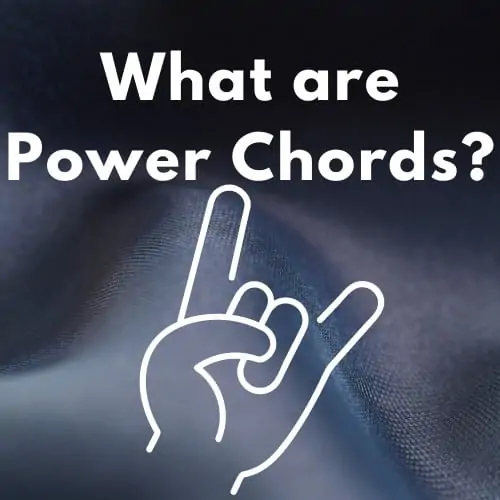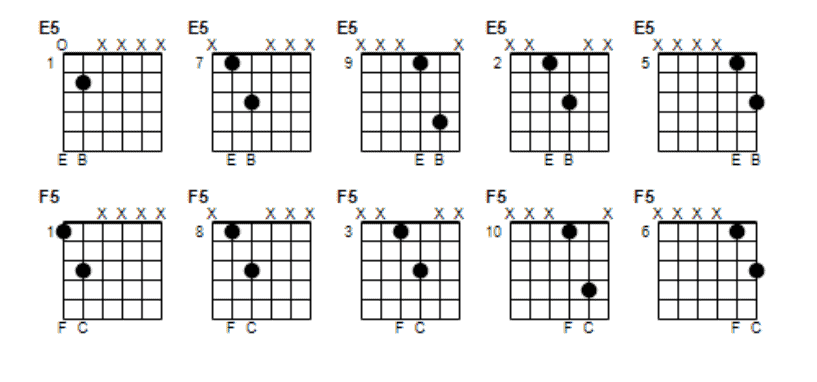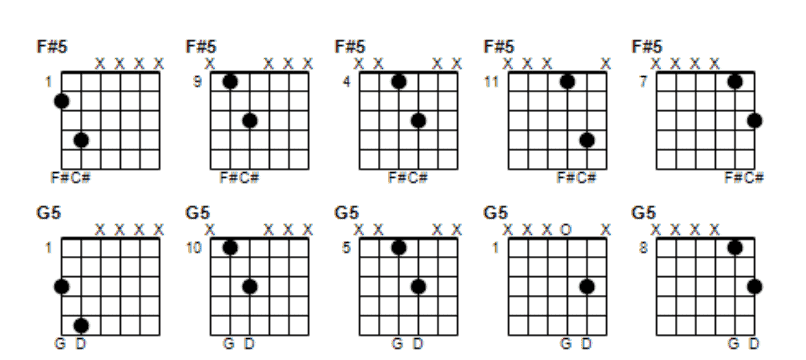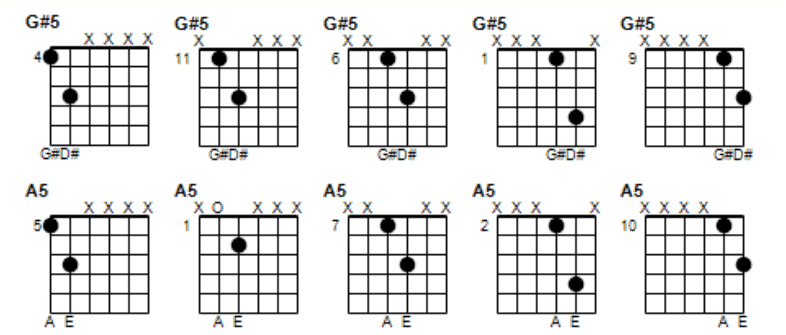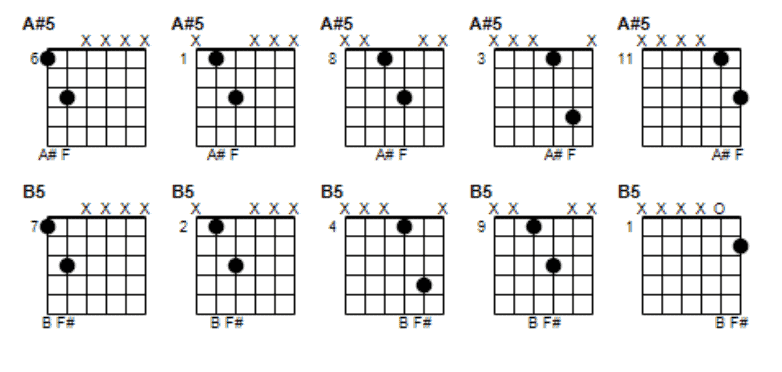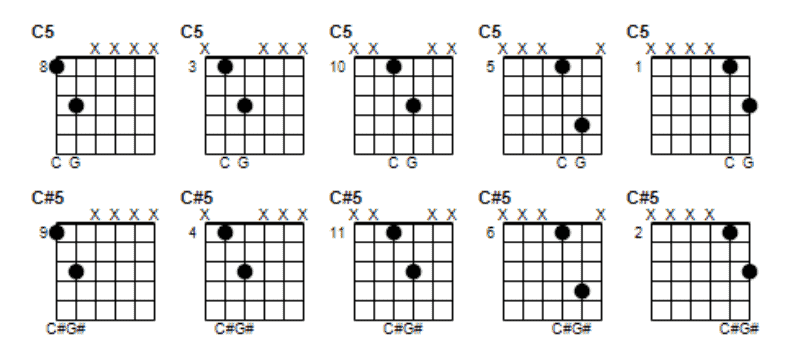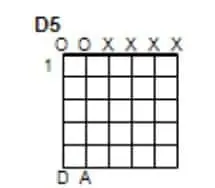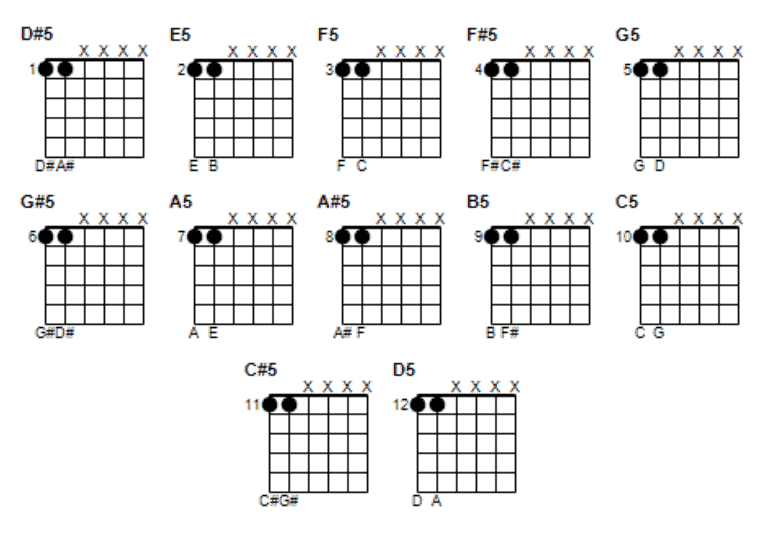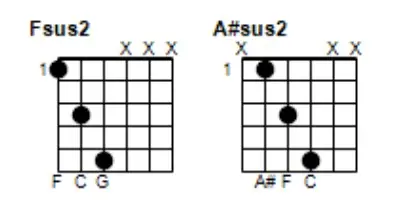Looking for a power chord chart for beginners? A chord is a group of notes that are played simultaneously. These chords make an integral part of the songs. The chords make up one of the three integral parts of any music called Harmony, the other two being Melody and Rhythm. Any and all types of music contain these three components in various amounts according to the genre, tradition and the evolution of music.
For example, the jazz music has a complex harmony and is mostly based on improvisation whereas the Indian Classical music focuses more on the melodic improvisation over a drone harmony. Metal music has a characteristic distorted sound with generally a fast rhythm, exotic or harmonies based on power chords and guitar riffs whereas the Western Classical Music generally has a diatonic harmony and a melody. The Pop songs have all of these elements in a simple form and hence gives them a balanced sound that is liked by the masses.
The balance of these three integral parts of music plays a distinctive role in determining how some genre is perceived by the human mind. So here we will take a look at the power chords that have been used extensively in the Rock, Metal and punk rock genres and how these chords can be used as a foundation for building more diverse chords.
Contents
What are Power Chords?
Power chords, also known as fifth chords, are two note chords. They are built by using a root note and its fifth interval. These chords are represented by a symbol that has a structure of root note of the chord followed by number 5. For example a C power chord is represented by ‘C5’ and contains the notes C and G (the fifth of C).
The major or minor third interval that gives a chord its major or minor quality is left out in a power chord. An octave interval of the root note is usually added to a power chord to make it sound fuller.
Power chords are usually played on a guitar with distortion owing to their prevalent use in Rock and Metal music. But these chords are not limited to these heavy genres. Jazz music, Reggae and many more guitar genres show the use of power chords. This shows that power chords are very versatile and can be used creatively to shape your sound and the songs.
How to build power chords on whole fretboard
Power chords are built using a very simple pattern on the guitar fretboard. You can start by placing your index finger on any note of the sixth string. Then place your ring finger on the fourth string by incrementing the fret number by 2. For example, if you place your index finger on 6th string 5th fret, you should place your ring finger on 4th string 7th fret which will give you a A power chord i.e. A5 chord.
This shape is moveable to all the frets with your root note lying on 6th, 5th, 4th and 2nd strings. For building a power chord with root note on the 3rd string, you need to increment the 2nd string by 3 frets instead of the normal 2 frets and use your pinky instead of your ring finger.
Power Chords Chart
Note: This anomaly arises because of the standard tuning of the guitar as all the 6th-5th, 5th-4th, 4th-3rd and 2nd-1st string pairs are tuned in fourth intervals whereas the interval between 3rd and 2nd string is major third.
If you want to add octave to your power chords you need to add your pinky/little finger on the same fret as your ring finger on the adjacent higher string for root note on 6th and 5th strings. If your root lies on the 4th string, then place your pinky one fret higher than your ring finger on the string adjacent to your ring finger. If your root note lies on the 3rd string then you will have a power chord with your index finger playing the root note, your pinky playing fret incremented by 3 on the 2nd string and then you will add your ring finger on the 1st fret on the 1st string.
Open power chord shape with octave extension
Power chord shape with octave extension
You can shift these shapes all over the fretboard.
Tip: To get a non-muddy sound, play only the strings that are fretted and mute all the remaining strings by lightly resting your index finger on the remaining strings.
This may seem daunting to you at first but observe the shapes carefully and try to understand the relationship between the notes. Once you are familiar with the shapes then try and visualise the intervals. Spend some quality time practicing and drawing and playing these chords and this will build a strong foundation for your guitar progress.
Use of power chords in rock and metal music
Power Chords is a debated term and many theorists say that these are not really chords and classically power chords would be called dyads. But in Rock, Heavy metal and other similar genres, the term has been completely accepted.
Use of power chords can be dated back to many decades and possibly even centuries. Use of power chords can be seen in Blues guitar which later rolled on to the Rock and Roll scene. The discovery of highly distorted guitar sounds and their rising popularity among the people led to a revolution in the music scene. As heavy metal, punk rock and other heavy genres began to gain popularity, the use of power chords increased rapidly and fast power chord changes became the characteristics of this style of music.
Thrash metal bands like Metallica, Megadeth and many other bands that were formed in that period have riffs that exclusively use power chords. One of the most famous riffs that has been used by guitarists as a joke recently, yes you guessed it, Smoke on the water aka 0-3-5 riff uses power chords. Master of puppets by Metallica is a wonderful example of a riff that uses fast power chord changes. Black Sabbath to Green Day era, the power chords will unlock it all for you.
How to practice power chords
Most fun way of practicing power chords is by learning songs that use power chords. Practicing riffs that incorporate power chords will let you unlock your ability to write some powerful riffs yourself. Start with the simplest of the songs like Smoke on the water, Seven nation army, etc. You can then also try to figure out the chords by ear. This will help for your ear training as well.
As major and minor chords involve the major or minor third intervals respectively, try to figure out the power chords of the song first and then try to add other intervals to match the exact chords. You can also try to make heavier versions or covers of the pop songs.
You can also try to write your own chord progressions and then try to write a solo or a lead line over that chord progression. This will be a good point to start delving into rock or metal songwriting. Don’t worry even if you are still a beginner. Get some tips for songwriting. Some of the common power chord progressions are as follows:
Common power chord progression tabs
- A5-B5-F#5-F5
- G5-G#5-B5-A5-G#5-E5-G5
If you are looking for some more variants, then you can also try out Inverted power chords which means that you play the 5th degree in base followed by the root note on adjacent thinner strings. To play an inverted power chord, make the octave extension power chord shape and then remove your index finger. This will give you a slightly less powerful power chord. The shape of the inverted power chord will look like:
Power chords in Drop tuning
Drop tunings are very famous in the prog metal and metal genres. As the name suggests, the 6th string that is the thickest string is tuned down to sound the same as 4th string an octave below. Therefore instead of the 6th string being E, it will be tuned to D making the Drop D tuning D-A-D-G-B-E. This tuning can be further lowered if all the strings in drop D are lowered by the same interval. Learn more about Drop D tuning. This tuning makes the sound heavier so try and have fun with this awesome tuning.
Playing power chords with the root note placed on the 6th string in Drop tuning is easier than playing the same chord in standard tuning. It is also easier to shift the chords in this tuning. For the open power chord shape, you just need to play the 6th string and 5th string open and mute rest of the strings. To add octave to this chord, you will need to play the 6th, 5th and 4th strings open and mute the rest. To shift this shape on further frets, select a root note on 6th string and to make it a power chord, play on the same fret on 5th string. To add octave to this, hold down the same fret of the 4th string as well.
I think that this is the easiest way to play the power chords and also get a break from the standard tuning. Here are some shapes that you can refer to while practicing power chords in drop tuning.
Drop d power chord open shape
Only the shapes of the power chords that have their root note on the 6th string will change. All the other shapes will be the same.
Chord chart for Drop D power chord shapes with root note on the sixth string.
How to build extensions on power chords
Power chords can act as the foundation for building a variety of more complex chords. The most basic extension is the addition of an octave of the root note that we discussed above. The other common extensions include the major or minor third, 7ths and 9ths.
To do this you should be familiar with basic guitar music theory and the placement of notes on the guitar fretboard. For example, the C major scale consists of notes C-D-E-F-G-A-B-C. Learn more about guitar keys.Therefore adding a 7th extension to a C major chord means that you add a B note to the C major chord. Here are some shapes that you can shift on the guitar fretboard to get some nice chords.
To create an sus2 chord with root note on 6th and 5th strings, make a chord shape of octave extension and then move the pinky 2 frets higher.
Sus2 Chord shapes/Natural 9 Power Chord shapes
Major7 Power chord shapes
To create a major7 power chord, again make the shape of octave extension but this time use your pinky to play the 5th interval and on the next string, add your ring finger one fret lower to the octave.
Flat5 Power Chords
To create a Flat5 power chord, make the octave extension shape and in that shape move your ring finger by one fret. You can shift these shapes throughout the fretboard too.
These extended chords can give a new dimension to your playing and make your songs sound more sophisticated and complex. The use of these chords to make chord progressions depends on your experimentation. Best way to learn to accommodate these chords in your playing is by trying out different combinations and then finding what works best for you. My favourite chord is Amadd9 because of its melancholic sound. You should spend time with these chords and find your favourites.
Conclusion
Practice these Power chords and incorporate them into playing as per your taste. Don’t try to just go by its stereotypic use in Heavy music. Experiment with the power chords and make their power your own.

